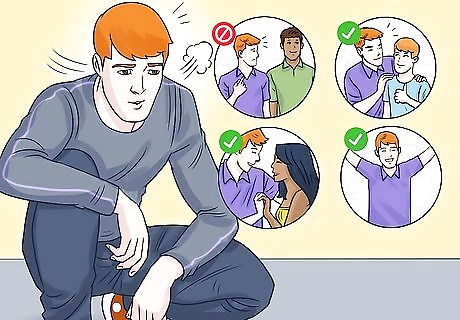
views
- The Enneagram Type 3 personality (or the “Achiever”) is driven by accomplishment and success.
- They rely on external validation and admiration to feel good about themselves, which sometimes results in low self-worth or excessive vanity.
- The Three personality type is often seen as charismatic and confident. But when struggling with self-esteem, Type 3’s insecurities may manifest as jealous behaviors.
Enneagram 3 Personality Traits

Enneagram Type 3 is known as the “Achiever” or “Performer.” This personality type is self-assured, charming, ambitious, and energetic. While they may be overly concerned with self-image and others’ perception of them, they are ultimately diplomatic and charismatic people who value their relationships.

At their best, Type 3s are confident and authentic. Healthy Threes are often seen as gracious and talented role models. Others look up to them because of their accomplishments and how they contribute their skills to the world around them. They have a high sense of self-worth and are usually well-liked and popular.

Type 3s may struggle with low self-esteem and jealousy. While they appear confident and ambitious to others, the Three typically needs external validation to feel good about themselves. A Type 3 may also become so focused on their own goals and accomplishments that they neglect the feelings of those around them. Every personality type has flaws and struggles, but these can be overcome by developing self-awareness, as well as understanding personality types and their impact on others. To feel better about themselves and how they treat others, Type 3s should focus on what they really feel and want, instead of being worried about their image or how others view them.

A Type 3’s core desire is to be admired by others. They are motivated by a basic need to distinguish themselves from others through achievement and success. They seek out a high status in life that will earn them respect and praise from both loved ones and strangers. Relatedly, Type 3’s core fear is being seen as worthless, incompetent, or unsuccessful. It’s important to them to be perceived as the best at everything they attempt.

Enneagram 3’s core values are productivity and achievement. Similar to a Type A personality, Type 3s are extremely organized and disciplined. A Type 3 usually has a busy schedule filled with meetings and new projects. They are also extreme perfectionists who want to do their best work possible, although they may be overly critical of themselves and others.

Type 3s want to be noteworthy and “star” members of their family. They may want to give their families status symbols like fancy cars or a big house. As children, they work hard to be the most responsible children in class and make their parents proud with accomplishments like joining student government or going to an elite university. As parents, Type 3s are dependable and consistent with their children. However, they may overlook their child’s emotional needs in order to provide them with the newest shiny thing.

Type 3s are a heart-based personality type, along with 2s and 4s. The personalities in this heart-based triad are very emotional and struggle to feel loved by others. However, Type 3 will avoid their feelings if they get in the way of their tasks or accomplishments. A Type 3 personality may also have a Two-wing or Four-wing. These “wings” represent supplemental traits that come from the types adjacent to someone’s core personality. In this case, someone with a core Type 3 personality may adopt some traits of the adjacent Two or Four, making them a Type 3w2 or 3w4, respectively.

The Enneagram Type 3 is a fairly common personality type. It is just about in the middle of global personality type distribution, being neither extremely rare nor extremely common. About 10.2% of the world population is a Type 3, including celebrities like Dwayne “The Rock” Johnson, George Clooney, Taylor Swift, and Serena Williams. Many fictional characters are also identified as Type 3s, like Regina George (Mean Girls), Blossom (The Powerpuff Girls), and Rachel Green (Friends).

Type 3s can be recognized by their tasteful and refined appearance. Their clothes are very polished and elegant, and they always look put together. Every part of a Three’s life—from their Instagram feed to their five-year plan—is well-thought-out and planned to a T. Type 3s can also be picked out of a crowd thanks to their charisma and ease in social situations. They can get along with almost anyone, and they excel at making polite and interesting conversation.

Enneagram Type 3s are distinct from other types. It can be difficult to determine someone’s personality type due to the many shared traits between each one. Here are some personality types that frequently get mixed up with Enneagram 3: Type 4 is similarly intense and image-focused, but this Individualist type is more preoccupied with relationships than career goals. Type 5 is also task-oriented and avoidant toward their own feelings, but they will space out their bursts of productivity with time for reflection. Type 6 is just as practical and personable as the Three, but the Six is uncomfortable with compliments and being the center of attention. Type 7 is an energetic and busy bee, just like Type Three, but they are more interested in their own enjoyment than how others perceive them. Type 8 is determined and goal-oriented, but the Protector is extremely stubborn and confrontational when obstacles are in their way. Type 9 depends on external approval, but they are more slow-paced than the Three and are easily influenced by the opinions of others.
Type 3 Variations: 3w2 & 3w4

A Type 3 may exhibit some traits of a Type 2. These traits indicate that the Three has a Two-wing, also known as a Type 3 Wing 2 or 3w2. Type 3w2 maintains the energy and ambition of Type 3, but they are more empathetic and focused on the people around them. This type of personality is referred to as “The Charmer,” which is a subcategory of the Type 3 “Achiever.”

A Type 3 may share traits with the neighboring Type 4. The resulting personality type is known as the Type 3 Wing 4 (3w4) or “The Professional.” Type 3w4 is extremely goal-focused and achievement-oriented, but they take on Type 4’s values of openness and honesty. Unlike a pure Type 3 personality, the 3w4 is also very expressive and vulnerable.
Type 3’s Levels of Healthy Development

Each Enneagram type contains 9 Levels of Development. These levels account for the variations between people of the same personality type, assessing whether their personality traits are healthy (high-functioning), average (normal behaviors), or unhealthy (dysfunctional behaviors). Any given person may operate at different levels throughout their life, or even just their day.

Healthy Type 3s operate at levels 1-3. At these levels of development, the Three has let go of their ego and self-image. They have moved beyond the limits of their Enneagram type into a place of more self-awareness and self-worth. Level 1: Charming, gracious, and authentic. Using their skills to help others rather than advancing their own goals. Level 2: Talented and accomplished, no longer needing admiration from others to feel good about themselves. Level 3: Ambitious and admired by others, often seen as a positive role model for others.

Average Type 3s operate at levels 4-6. Most people exist within the average range of their personality type. In the average levels of development, an individual is still motivated by their Enneagram type’s core fear, but they are reasonably self-aware of their negative traits and less reactive to triggers. Level 4: Extremely concerned with image, professional success, and how others view them. Level 5: Very focused on how they are perceived and aligning to others’ expectations, to the point where they ignore their own feelings and wants. Level 6: Wants to be the best at everything in life. May become resentful and envious of others whom they see as more liked or successful.

Unhealthy Type 3s operate at levels 7-9. At unhealthy levels, the Three has not grown past their core fears of worthlessness and being undervalued. These fears dominate their personality, which can lead to destructive behavior or addictions like starvation diets, workaholism, exercise addition, or reliance on stimulants like amphetamines or caffeine. Level 7: Bases their self-worth solely on other people’s opinions, to the point where they may make up stories about themselves to seem more interesting, admirable, or successful. Level 8: Extremely fearful of having their mistakes or perceived failures exposed, so they may betray or sabotage others in order to maintain the appearance of superiority. Level 9: The most extreme level of unhealthy Type 3s may show psychopathic behavior or traits of Narcissistic Personality disorder like obsessive jealousy or resentfulness toward other people’s happiness. Remember that these destructive behaviors are coming from a place of low self-esteem or fear, not malicious intent. By self-reflecting or getting counseling, these traits can be addressed and managed.
Personal Growth as an Enneagram 3

Type 3s can become healthier by improving their self-worth. A Type 3 must understand that there is more to them than their achievements. They are worthy and lovable just as they are, without any financial or professional success. To improve their self-worth, Type 3s should also: Avoid competing with others. A Type 3 can continue setting goals for self-improvement and competing against themselves. But competing with others is useless, as there will always be people with more money or more talent. Focus on genuine relationships. Happiness comes from developing healthy relationships with friends and family. Loyal loved ones will cherish and accept the Type 3 no matter where they are in life. Embrace intimacy. The Three must be willing to open up emotionally and physically to others. Being vulnerable and expressing their feelings clearly and honestly will show them that there’s nothing to be scared of. Take breaks. Nobody can be their most successful self if they exhaust themselves. The Type 3 must set aside time to practice self-care, get enough sleep, and enjoy the simple things in life.
Type 3 in Romantic Relationships

Type 3s value care and competence in a partner. They are looking for someone who can complement their intensity and ambition. They have a deep need to be seen and valued for who they really are, so they need a partner who will take the time to understand and appreciate them. When unhealthy, a Type 3 may let their preoccupation with achievement impact their relationship. Their romantic partner may feel like they have to compete for the Type 3’s attention.

The Type 3 struggles to be vulnerable. In a relationship, they need a safe space to let their guard down and be honest about their feelings. A partner can support them by listening to them with an open mind and constantly reassuring them of their unconditional love and admiration.

Type 3s are most romantically compatible with other Type 3s. These matching personalities often make for a power couple, as they combine their talent and productivity to great success. However, they must be sure to make space for their emotions and slow down every once in a while. Type 3 & Type 1: Shared dedication to tasks and productivity, but a clash between Type 1’s morality and Type 3’s vanity. Type 3 & Type 2: Three receives love and acceptance from 2, but the 3 can’t fulfill the 2’s need for emotional connection. Type 3 & Type 4: Good balance between the energetic 3 and the introspective 4, but an emotional mismatch that leads to frequent misunderstandings. Type 3 & Type 5: The 3 brings the 5 out of their shell, but the Type 5 has a slower approach to life than the 3. Type 3 & Type 6: The 6 helps the 3 to be more grounded and vulnerable, but they are slow to trust the shapeshifting and unreliable Type 3. Type 3 & Type 7: Shared love for adventure and spontaneity, but their busy schedules lead to ignored conflict and stalled communication. Type 3 & Type 8: A match in passion, assertiveness, and intensity, but an equal match explosive tension and conflict. Type 3 & Type 9: Mutual support and encouragement, but the Type 3 may feel like they’re being held back by the slower-paced 9.
Type 3 in the Workplace

The Type 3 is an extremely adaptable and dedicated worker. They thrive off of working with diverse groups in different environments. They enjoy working toward goals and will motivate others to do the same. Type 3s are extremely charismatic and make natural leaders and role models.

Type 3s may be overly competitive in the workplace. Because the Three always wants to be the very best at what they do, they may come across as arrogant or be jealous of a colleague’s success. Threes are also very perfectionistic, so they may focus too much energy on work and unrealistically expect others to match their effort.

Enneagram 3s are suited for fast-paced and busy careers. They thrive in workplaces that require energy, quick decision-making, goal-setting, and a high level of autonomy. The best jobs for Enneagram Type 3s are executives, managers, computer programmers, or entrepreneurs. Due to their charismatic and social traits, the Three will also succeed in careers like acting, production, journalism, and law.

















Comments
0 comment